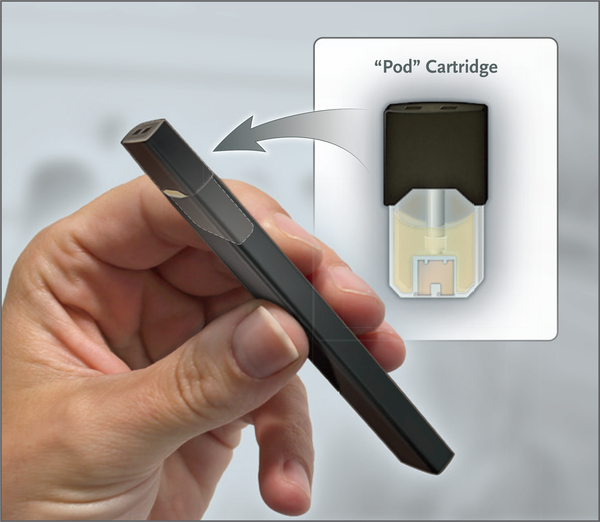Adolescents’ use of electronic cigarettes initially took the public health community by surprise. In 2011, less than 2% of U.S. high school students reported having used e-cigarettes in the previous month. But by 2015, the percentage had jumped to 16%. The following year, the U.S. Surgeon General issued a report concluding that e-cigarette use among young people was “a public health concern.” Ensuing public education campaigns and policies helped bring the prevalence of past-month e-cigarette use among U.S. high school students down to 11% in 2016.1
A recent evolution in technology and marketing may threaten this progress. A new product class called “pod mods” — small, rechargeable devices that aerosolize liquid solutions containing nicotine, flavoring, and other contents encapsulated in cartridges (see graphic) — appears to be gaining traction. Media stories about Juul, a popular pod mod brand, highlight anecdotal reports from students, parents, teachers, and school superintendents indicating that use of these products is rampant among young people. According to Nielsen data, as of January 27, 2018, Juul had captured 49.6% of the e-cigarette market.2 There is reason to be concerned that adolescents’ use of pod mods is not a passing trend and could bring a host of adverse health consequences to the current generation of adolescents and young adults.
Juul Pod Mod.
A Juul’s pod cartridge resembles a USB drive.
Pod mods may deliver high levels of nicotine with few of the deterrents that are inherent in other tobacco products. Traditional e-cigarette products use solutions with free-base nicotine formulations in which stronger nicotine concentrations can cause aversive user experiences. Juul and other pod mods use protonated nicotine formulations derived from the nicotine salts in loose-leaf tobacco. According to their advertisements, nicotine salt solutions contain nicotine concentrations 2 to 10 times those found in most free-base-nicotine e-cigarette products. Juul’s website indicates that there is 0.7 ml of nicotine per pod (concentration, 59 mg per milliliter [5%]) — equivalent to approximately 20 combustible cigarettes. According to a patent application, the combination of salt-based nicotine and other additives results in a satisfying experience even at high nicotine concentrations.3
This innovation in nicotine chemistry may be critical with regard to the addictiveness of pod mods. Combustible cigarettes deliver high doses of nicotine as well, but the noxious taste and sensations of the initial smoking experience discourage some young people from continuing to smoke. Pod mods may deliver an addictive dose of nicotine without an aversive user experience or other tobacco-related deterrents — which may be one reason why 80% of 15-to-24-year-olds who try Juul continue using the product4 and why social media posts saying “addicted to my Juul” are common.2
Pod mods are easy to conceal from authority figures. As compared with many e-cigarette devices, they generally need less electrical power to deliver high doses of nicotine and so are compact. Juul vaporizers measure 9.4 cm by 1.5 cm by 0.8 cm and weigh only 0.01 kg. They are inconspicuous, closely resembling computer USB drives. Young people can therefore readily conceal them, and teen use of pod mods on school grounds, including use during class time, is reportedly widespread (see image).2
Pod Mod Use in a Classroom.
Furthermore, pod mods may appeal to a wide audience. They have a sleek, modern design, and their packaging resembles that of a smartphone. Customizable adhesive covers for Juul (like mobile-phone cases) are marketed as “skins” — the same term used for the visual personae that videogame players can select to represent their gaming characters. Juuls are available in attractive-sounding flavors, including “creme,” “fruit medley,” “mango,” and “cool mint,” and are easy to use. Many e-cigarette devices require purchase of solutions from independent manufacturers, manual refilling, and user calibration. With most pod mods, consumers merely open their starter kit package, slide a flavor pod into the device, and start vaping.
Although there may be far less diversity and quantity of toxins in e-cigarette aerosol than in combustible cigarette smoke, e-cigarettes are not without risks. Their aerosol can include metals, volatile organic compounds, and flavoring additives, which may be harmful when inhaled, particularly to adolescent users, who in fact are more likely than nonusers to report having respiratory symptoms.1
Moreover, nicotine adversely affects the developing brain and causes addiction. Adolescent exposure to nicotine is associated with an increased risk of mood and attention problems.1 Nicotine is the principal constituent responsible for the substantial addictiveness of tobacco products. Symptoms of nicotine addiction, such as drug withdrawal and forfeiture of social, occupational, or recreational activities in favor of nicotine use, cause substantial distress and impairment. Given the high nicotine concentrations in pod mods, the nicotine-related health consequences of use by young people could be worse than those from most e-cigarette products. Yet 63% of 15-to-24-year-olds surveyed did not know that nicotine is present in all Juul products.4
E-cigarette use may increase the risk for combustible-cigarette smoking. A consensus report of the National Academies of Sciences, Engineering, and Medicine concluded that adolescents and young adults who use e-cigarettes are more likely than nonusers to start smoking combustible cigarettes, and it cited evidence that higher nicotine concentrations may heighten the risk of such a transition.1 It’s important to study how and to what extent the increased popularity of pod mods among adolescents affects the prevalence of combustible-tobacco use among young people.
Since many pod mods are virtually indistinguishable from USB drives, some schools have banned all USB drives from their grounds. School districts have launched parent- and teacher-education programs to inform adults about pod mods and how to determine whether their children or students are using them. We believe that schools should emphasize zero-tolerance policies for the possession of any tobacco products on school grounds. There are several school-based educational programs focused on prevention and cessation of tobacco use that are considered promising by the Substance Abuse and Mental Health Services Administration’s National Registry of Evidence-Based Programs and Practices and by other agencies. Such programs may provide a useful launching point for the development of evidence-based interventions addressing pod mod use by adolescents.
On April 18, 2018, six public health organizations urged the Food and Drug Administration (FDA) — the federal agency charged with regulating e-cigarettes — to take action to prevent “Juul-ing” by young people.5 The group urged the FDA to act to suspend Internet sales of Juul until stronger regulations can be implemented to prevent online purchases by young people and to increase enforcement of restrictions against e-cigarette sales to minors in brick-and-mortar stores. It also encouraged the FDA to advance the deadline (currently set for 2022) for determinations of whether existing e-cigarette products may remain on the market. A coalition of 11 U.S. senators also recently wrote to the FDA with similar concerns and called for the prohibition of sales of e-cigarettes in “kid-friendly” flavors.
The FDA has begun to take action. On April 24, 2018, the agency announced recently initiated, nationwide, undercover operations to identify and intervene with retailers that sell e-cigarettes to minors, restrictions against third-party resale of Juuls on the popular shopping website eBay, and detailed requests for information from the manufacturer of Juul to aid FDA efforts to prevent Juul-ing by young people. Comprehensive actions are urgently needed to counteract adolescents’ use of pod mods and other e-cigarettes. In the meantime, we advise physicians and parents to remain on alert regarding this emerging public health concern.
Footnotes
Disclosure forms provided by the authors are available at NEJM.org.
Contributor Information
Jessica L. Barrington-Trimis, Department of Preventive Medicine, Keck School of Medicine, University of Southern California, Los Angeles. USC Norris Comprehensive Cancer Center, Los Angeles.
Adam M. Leventhal, Department of Preventive Medicine, Keck School of Medicine, University of Southern California, Los Angeles. USC Norris Comprehensive Cancer Center, Los Angeles. Department of Psychology, University of Southern California, Los Angeles.
References
- 1.National Academies of Sciences, Engineering, and Medicine. Public health consequences of e-cigarettes. Washington, DC: National Academies Press, 2018. [PubMed] [Google Scholar]
- 2.Kavuluru R, Han S, Hahn EJ. On the popularity of the USB flash drive-shaped electronic cigarette Juul. Tob Control 2018. April 13 (Epub ahead of print). [DOI] [PMC free article] [PubMed] [Google Scholar]
- 3.Brown A, Xing C. U.S. patent no. 9215895: nicotine salt formulations for aerosol devices and methods thereof. December 22, 2015.
- 4.Willett JG, Bennett M, Hair EC, et al. Recognition, use and perceptions of Juul among youth and young adults. Tob Control 2018. April 18 (Epub ahead of print).
- 5.Leading health and medical groups urge immediate FDA action to address rising youth use of Juul e-cigarettes. Press release of the American Lung Association, April 18, 2018. (http://www.lung.org/about-us/media/press-releases/fda-action-juul.html). [Google Scholar]




